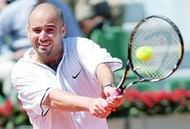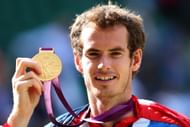In 2001, Goran Ivanisevic won the coveted Wimbledon title, nine years after he lost to Andre Agassi at the Centre Court. But it was twilight of Ivanisevic’s career. The world of tennis was in search of the champions who would dominate the circuit for years to come, much like what Pete Sampras and Agassi had done in the previous decade.
Sampras and Agassi – the American duo had won majority (22 out of 52 Grand Slams) from 1990 to 2002. The clay courts did not suit both their styles. In spite of that, Agassi managed to clinch a French Open title in 1999.
When Andy Roddick won the US Open in 2001 at the age of 19, the tennis fraternity believed that the next “big thing” had arrived. Pete Sampras echoed their sentiments and expected Roddick to win many Grand slams. But Roddick failed to add another Grand slam title to his kitty and remained an under-achiever in his twelve year professional career.
The likes of Lleyton Hewitt, Marat Safin and David Nalbandian were expected to be the next big superstars in men’s tennis. But one name dominated the world tennis at that time. A young Swiss named Roger Federer set unprecedented standards in men’s tennis and became the man to beat. They tried and tried to match his standards, but Federer played at a different level altogether. The return of serves, the single-handed powerful backhand, the surgeon-like accuracy in placing the ball just inside the base line and angles created while playing both the forehand and backhand, made Federer special. Not to forget his deft touches at the net, that he used time and again to surprise his opponents.
 Rafael Nadal announced his arrival with a French Open win in his maiden appearance. His rivalry with the top seeded Federer became a high point in the sporting spectacle. Their encounters were often compared with Bjorn Borg and John McEnroe’s rivalry in the 1980s. The whole debate of “Finesse vs Power play” arose during their epic clashes.
Rafael Nadal announced his arrival with a French Open win in his maiden appearance. His rivalry with the top seeded Federer became a high point in the sporting spectacle. Their encounters were often compared with Bjorn Borg and John McEnroe’s rivalry in the 1980s. The whole debate of “Finesse vs Power play” arose during their epic clashes.
With Nadal out of action, nursing his knee injury and Federer being at the wrong side of the 30s, the opportunity is just right for the next set of torch-bearers to win the Grand Slams. The last 32 Grand Slams (from Australian Open 2005 to the US open 2012) have seen just six winners – Marat Safin, Rafael Nadal, Roger Federer, Novak Djokovic, Juan Del Potro and Andy Murray. Compare this with the 32 Grand Slams prior to the above mentioned period (Australian Open 1997 to the US Open 2004) – there were 15 distinct Grand Slam winners.
Who will rule Men’s Tennis for the next five years?
Federer is the world number one at the current moment. At 31, he has not shown signs of slowing down, neither has there been a dip in his form. The way Federer won his seventh Wimbledon title, beating Andy Murray (a much younger opponent), just goes to show that “age is just a number” for the Swiss maestro. But Federer might not be around for a long time.
Murray is the next big hope as far as men’s tennis is concerned. The Scot won an Olympic Gold medal, a month after losing to Federer at the Centre court. Murray then clinched the US Open, beating Novak Djokovic in a five set thriller. The consistency in the serve, the return of the serves and working out opponents’ weakness during a long rally has helped Murray improve as a player since last four years. Ivan Lendl’s association has immensely helped the Scot translate his bagful of potential into substantial performances.
 The Serbian sensation Djokovic has been a fierce competitor since last five years. He rose to prominence courtesy his never-say-die spirit and intelligent play on the court. He upstaged Federer’s dominance at the Australian Open(2008), the US Open(2009) and the French Open(2012). The Serb has also challenged the Spaniard Rafael Nadal on the court in the last two years. The epic Australian Open final which lasted for more than five hours, was a fiercely competitive affair. Djokovic’s victory indicated a shift of power in the tennis fraternity, with three players now fighting for the domination in the International circuit – a place hitherto occupied by Federer and Nadal.
The Serbian sensation Djokovic has been a fierce competitor since last five years. He rose to prominence courtesy his never-say-die spirit and intelligent play on the court. He upstaged Federer’s dominance at the Australian Open(2008), the US Open(2009) and the French Open(2012). The Serb has also challenged the Spaniard Rafael Nadal on the court in the last two years. The epic Australian Open final which lasted for more than five hours, was a fiercely competitive affair. Djokovic’s victory indicated a shift of power in the tennis fraternity, with three players now fighting for the domination in the International circuit – a place hitherto occupied by Federer and Nadal.
Then there is the 2009 US Open champion – Del Potro. His forehand is a very strong weapon. But the inconsistency in winning long rallies just goes against Argentina’s No. 1 on numerous occasions. He has the ability to topple any of the top four ranked player on his day. But will he continue to sustain the same momentum for a long period of time?
David Ferrer has been acknowledged by Federer of being the “fittest man on the tour and the best returner of service in men’s tennis”. Ferrer does not give up easily, but his skill set is limited. He does not have variations in his play. Serve and volley option is hardly used by him, as his reluctance to come to the net more often and buckling down while a long rally goes on, are some of the things which have prevented Ferrer to break into the top four for some time now.
Jo-Wilfred Tsonga’s bullet serves and aggressive style of play have helped him to some memorable wins. At the Australian Open, 2010, Tsonga outclassed Nadal in just three sets. Next year, Federer was demolished at the Wimbledon in the quarter final summit. Tsonga came back from two sets down to thrash the then six time champion at Wimbledon.
Tomas Berdych has been Federer’s nemesis since the 2004 Athens Olympics. Berdych inflicted a serious upset, beating Federer at Wimbledon (2010) and US Open (2012). He also entered his first grand slam final, beating Djokovic in the semifinals of the Wimbledon in 2010. But Berdych has somehow failed to play his “A-game” when it matters the most. Will this change in the new season?
Tennis circuit is in need of new champions. People who can raise the levels even higher; the ones who can beat Murray, Djokovic and Federer consistently. Currently, there seems to be no one around. But there will come a time, when some of the youngsters have to shoulder the responsibility of continuing the legacy of the greats of the game, who have taken the game to a different level. We are waiting for them.
Who Are Roger Federer's Kids? Know All About Federer's Twins


